
|
Babydoll Southdown SheepThe Olde English Babydoll Southdown is a miniature variety of the Southdown breed. The Southdown breed of sheep originated in the Southdown hills of Sussex County, England. It is one of the oldest purebred sheep breeds in the world. Southdowns were imported to the United States in the early 1800's. The 1960's saw increased importation of the larger New Zealand Southdown to upscale the American Southdown. |

|
Badger Face Welsh Mountain SheepThe Welsh Mountain Badger Face is a color variation (a recessive trait) of the Welsh Mountain. It is an ancient Welsh breed, which was once common in the Welsh Mountains. Numbers of the breed fell during the Middle Ages when the cloth trade demanded a white wool. Numbers are now on the increase. The main type is known by Torddu which means blackbelly, but there is also a rarer Torwen which is the reverse coloration, black with a white belly. |

|
Balwen Welsh Mountain SheepThe Welsh Mountain Sheep can be termed as an umbrella description to describe many of the breeds indigenous to Wales. Through breeding and selection over the centuries, the Welsh Mountain has developed into many distinct breeds; the Balwen Welsh Mountain Sheep being one of these. Balwen Welsh Mountain Sheep originate from one small area of Wales: the Tywi Valley. The name Balwen is welsh for white blaze. |

|
Barbados Blackbelly SheepThe Barbados Blackbelly is an indigenous breed to the Caribbean island of Barbados. It descends from sheep brought to the islands from West Africa during the slave era. Blackbellies are "antelope like" in appearance, brown tan or yellow in color, with black points and under-parts. Both ewes and rams are polled or have only small scurs or diminutive horns. |

|
Bavarian Forest SheepThe Bavarian Forest, the successor of the Bavarian Zaupel, is decreasing in popularity and appears in the Bavarian herdbook only since 1987. Nevertheless it is an old and once wide-spread breed in its native region. It is a small to medium sheep, mostly white, though brown and black animals do occur. |
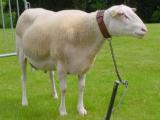
|
Belgium Milk SheepThe Belgium Milk Sheep is strongly influenced by Friesian Milk Sheep. In all probability, the Belgium Milk Sheep descends from Flemish sheep. Since the 19th century, Flemish sheep were selected for milk character. After the Second World War, the other milk sheep breeds were added. |

|
Beltex SheepBeltex sheep were first introduced to Britain from Belgium in 1989. They originate from hybrid sheep bred in Belgium. The breed's main characteristics are double-muscled highquarters, coupled with fine bones which ensures maximum killing-out percentage of the finished lamb. |
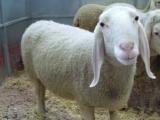
|
Bergamasca SheepThe Bergamasca originated in the North of Italy, possibly from Sudanese sheep. They are a multi-purpose animal, raised for meat, milk, and wool. They are prolific and produce and average of 250 kg of milk with 6 percent fat over a 6 month lactation period. |
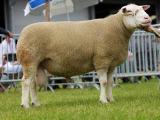
|
Berrichon du Cher SheepThe Berrichon du Cher was established in the Berry region of France. The original breed was crossed with a Merino in the mid-1780's. Further improvements were made in the 1800's with the introduction of the Dishely Leicester. |

|
Beulah Speckled-Faced SheepSpeckled-face sheep have been bred on the hills of Eppynt, Llanafan, Abergwesyn and Llanwrtyd Wells for over 100 years, without introduction of female stock. On the hill, the ewes are normally purebred, providing flock replacements, finished lambs for the meat trade, or store lambs for finishing on lowland farms. |

|
Black Hawaiian SheepThere is some controversy on how the Black Hawaiian breed was started. Some say it is a cross of Mouflon and black hair sheep from the Hawaiian islands. Others say they are Barbados with a dilution of the red color gene making them black. They have a thick black coat and are usually black all over, although some sport a white muzzle. |

|
Black Welsh Mountain SheepIn the Middle Ages, the mutton of black-fleeced Welsh Mountain Sheep was prized for its richness and excellence and much sought-after by merchants. During the mid-19th century, some breeders began to select specifically for the black fleece color and the result is the Black Welsh Mountain sheep. |

|
Blackheaded Persian SheepThe Blackheaded Persian originated in the arid regions of east Africa in what is now Somalia. It is one of the fat-rumped breeds and both sexes are polled. Blackheaded Persians have a white body and black head and neck with the two colors sharply distinguished. |
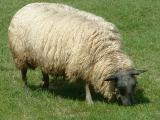
|
Bleu du Maine SheepThe Blue du Maine originated in Western France in the region of Mayenne. The breed was developed from crossing Leicester Longwool and Wensleydale which were imported during a period from 1855 to 1880 with the now extinct Choletais breed. The Blue du Maine is a large breed. The breed has no wool on its head or legs. The face is dark gray or blue color. Both sexes are polled. |

|
Blue Texel SheepThe Blue Texel is a color variant of the normal white Texel sheep. The Blue Texel came from white Texels who carry the color factor "blue" with them. This factor is a recessive factor. From a mating of two white Texels who both carry the factor for the blue colour, there is a 25 percent chance blue lambs will be born while a mating between a Blue Texel and another Blue Texel always gives blue lambs. Texel sheep evolved as a result of crossbreeding the Dutch polder sheep with several English breeds, such as Leicester, Wensleydale, and Lincoln at the beginning of the 20th century. |
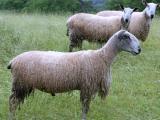
|
Bluefaced Leicester SheepThe Bluefaced Leicester evolved near Hexham in the county of Northumberland, England during the early 1900's. They are descendants of Robert Bakewell’s improved Dishley Leicester. The breed originated from Border Leicester individuals selected for the blue face (white hairs on black skin) and finer fleeces. It was was developed as a sire of high quality crossbred ewes. |

|
Bond SheepBonds evolved in Australia in 1909 as a dual-purpose breed, using Peppin Merinos and imported Lincoln rams. Bonds are tall, long-bodied sheep, heavy in the bone and with open faces and a robust constitution. They produce bulky, long-stapled, bright 22-28 micron wool. Lambs are long, lean, and fast growing. Bond rams weigh up to 150 kg (330 lbs.). |
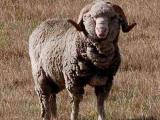
|
Booroola Merino SheepThe Booroola Merino was developed on the Southern Tablelands of New South Wales, Australia. It differs from the normal Merino in two ways. First, its fertlity is as high as any breed in the world. The number of lambs born per ewe lambing is 2.4, with a range of 1 to 6. Half-Booroola ewes on average wean 20 percent more lambs than comparable Merinos under the same conditions. Secondly, Booroolas have the ability to breed at most times of the year, thus extending the breeding season. |
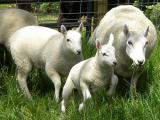
|
Border Cheviot SheepThe Border Cheviot originated as a mountain breed, native to the Cheviot Hills between Scotland and England, where the climate is harsh and the conditions are rugged. Cheviots are extremely hardy and can withstand harsh winters and graze well over hilly pastures. They were bred to look after themselves. Recognized as early as 1372, the breed is reported to have developed from sheep that swam ashore from shipwrecked Spanish ships that fled northward after the defeat of the Armada. |

|
Border Leicester SheepOne of three distinct breeds of Leicester sheep, the Border Leicester was founded in 1767 by George & Matthew Culley of Fenton, Northumberland, England. They were friends of Robert Bakewell and had access to his improved Leicesters. Some feel that the Culley brothers developed the Border Leicester by crossing Bakewell's improved Leicester rams with Teeswater ewes. Others argue that Cheviot blood was introduced. |

|
Borderdale SheepThe Borderdale was developed in New Zealand. It is the result of breeding the Border Leicester and Corriedale breeds and interbreeding each generation until the F5 stage. Borderdales are a medium-large, hardy, long-woolled breed, with a comparatively low susceptibility to foot rot. They have a good growth rate. |
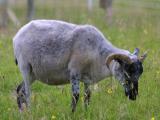
|
Boreray SheepThe Boreray originated on the island of Boreray which is in the St. Kilda group. The breed was developed during the late 19th century from Scottish Blackface and a Hebridean type of Old Scottish Shortwool. The breed has been largely feral since 1930. The Boreray is a small breed with no wool on face or lower legs. The extremities are black or tan colored. |
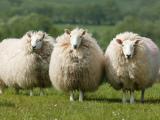
|
Brecknock Hill Cheviot SheepThe Brecknock Hill Cheviot was developed from the Scottish Cheviot that was introduced to Wales in the 1850's. Purebred Brecknock sheep come in all colors except spotted. They tend to be naturally small like their ancestors. However, their nature is much more gentle than the other Cheviot sheep. |
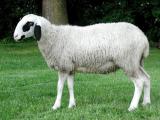
|
Brillenschaf SheepThe Brillenschaf from Carinthia is one of the endangered livestock breeds in Austria. Since 1938, it has almost completely died out. It is named for the eyeglass marks around its eyes, under the eyes, and on its ears. It is a cross between the old Landschaf breed with the Bergamasca and Paduaner Schaf. |

|
British Milk SheepBritish Milk Sheep are a composite breed whose exact make-up is in conflict. Breeds that comprise the composite include the East Friesian, Bluefaced Leicester, Polled Dorset, Lleyn, and perhaps other breeds. The breed was established and released in 1980. Animals of this breed are medium to large in size, polled, with white, woolless, face and legs. |
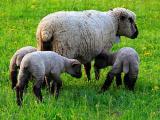
|
Brown Headed Meat SheepThe Braunköpfiges Fleischschaf is one of the four predominant sheep breeds in Switzerland. It is the heaviest breed. It was developed by crossing Oxfords from England and German Blackheaded Mutton sheep onto landrace sheep. |

|
Brown Mountain SheepThe home of this breed is the alpine regions of Bavaria (Germany), Tyrol (Austria), Southern Tyrol (Italy), and the Swiss Canton of Engadine. In recent years, the Brown Mountain Sheep has gained popularity beyond its original borders. The Brown Mountain Sheep descended from the Tyrolean Steinschaf (Stone Sheep), which can be of all colors, one color per sheep, and is rarely white. |